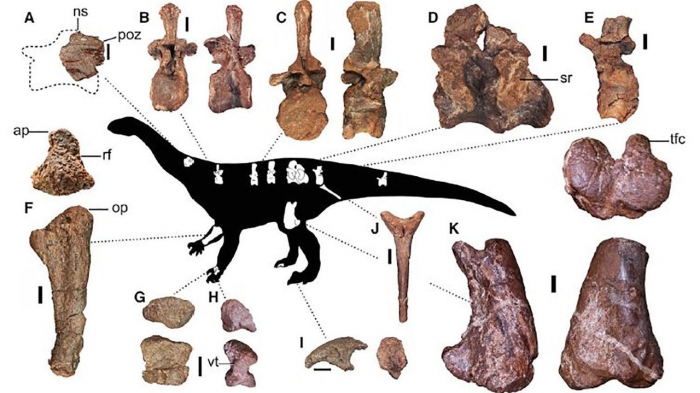The recently discovered fossil of a new dinosaur species in South Africa revealed a relative of the brontosaurus that weighed 26,000 pounds, about double the size of a large African elephant.
The researchers have named it Ledumahadi mafube, which is Sesotho for "a giant thunderclap at dawn." Sesotho is an official South African language indigenous to the part of the country where the dinosaur was found.
"The name reflects the great size of the animal as well as the fact that its lineage appeared at the origins of sauropod dinosaurs," said Jonah Choiniere, study author and paleontology professor at the University of the Witwatersrand in Johannesburg, South Africa. "It honors both the recent and ancient heritage of southern Africa."
Apart from its massive size, there are other evolutionary details about the new species that make it entirely unique, according to a new study published Thursday in the journal Current Biology.
"It shows us that even as far back as 200 million years ago, these animals had already become the largest vertebrates to ever walk the Earth," Choiniere said.
FINDING A NEW DINOSAUR
Choiniere's graduate student, Blair McPhee, discovered the bones of an unknown dinosaur in 2012.
"Blair told me how important he thought it was, and even showed me that some of its bones were still sticking out of the rocks in the field," Choiniere said.
Over years of excavation, the team uncovered the fossil of a fully-grown adult dinosaur, likely about 14 years old when it died.
Ledumahadi was a close relative of sauropod dinosaurs, like the brontosaurus and others that ate plants and walked on all four legs. But the fossil shows that it evolved earlier, and independently, of sauropods.
Sauropods had a posture and thick, column-like limbs that are very similar to elephants. But they evolved from ancestors that walked predominantly on two legs. Adapting to walk on all fours allowed sauropods to grow larger and supported the digestive process needed for their herbivore diet.
The researchers believe that Ledumahadi was a transitional dinosaur, an evolutionary experiment itself during the Early Jurassic period. The forelimbs of this dinosaur are more "crouched," while being very thick to support its giant body.
"The first thing that struck me about this animal is the incredible robustness of the limb bones," said McPhee, lead study author. "It was of similar size to the gigantic sauropod dinosaurs, but whereas the arms and legs of those animals are typically quite slender, Ledumahadi's are incredibly thick."
The researchers wanted to find out whether or not this dinosaur walked on two or four legs, so they developed a new method to test it. They compiled data of dinosaurs, animals and reptiles that walked on two or four legs, including leg measurements and thickness. Comparing the data from the fossil with this dataset enabled them to determine Ledumahadi's posture.
While the method helped them determine that Ledumahadi walked on four legs, it also revealed that other early similar dinosaurs were also experimenting with walking on all fours.
"The evolution of sauropods isn't quite as straightforward as we once thought," Choiniere said. "It appears that sauropodomorphs evolved four-legged postures at least twice before they gained the ability to walk with upright limbs, which undoubtedly helped make them so successful in an evolutionary sense."
LOCATION IS KEY
The newly discovereddinosaur is a close relative of gigantic dinosaurs that lived during the same time in Argentina, which supports the idea that all of the continents were still assembled as Pangea, a supercontinent made up of most of the world's land mass during the Early Jurassic.
"It shows how easily dinosaurs could have walked from Johannesburg to Buenos Aires at that time," Choiniere said.
When it roamed the land 200 million years ago, Ledumahadi lived in South Africa's Free State Province, but it looked very different then. Instead of the mountainous area that it is now, the land was flat and semi-arid, with shallow streams that could easily dry out.
And Ledumahadi was just one of many dinosaur species in the area.
"There was a thriving dinosaur ecosystem here in South Africa, at the bottom of the world, featuring 12 ton giants like Ledumahadi, tiny carnivores like Megapnosaurus, the earliest mammals, some of the earliest turtles, and many, many others," Choinere said.
He and his team are continuing to look for fossils in South Africa from the Triassic and Jurassic periods.
Ledumahadi also adds to the list of remarkable discoveries made in South Africa.
"Not only does our country hold the Cradle of Humankind, but we also have fossils that help us understand the rise of the gigantic dinosaurs," said South Africa's Minister of Science and Technology Mmamoloko Kubayi-Ngubane in a statement. "This is another example of South Africa taking the high road and making scientific breakthroughs of international significance on the basis of its geographic advantage, as it does in astronomy, marine and polar research, indigenous knowledge, and biodiversity."
Read the original article on ksl.com.
















































